Attainment Scotland Fund evaluation: headteacher survey report 2019
This report presents findings from a recent survey of headteachers of schools in receipt of support from the Attainment Scotland Fund (ASF). This is the fourth survey of headteachers, previous surveys having been conducted in 2016, 2017 and 2018.
3. ASF supported approaches
3.1. This section summarises survey findings on schools' experience in developing their approach, provides an overview of funded approaches, and considers the focus of schools' approach to achieving equity in education.
Developing approaches
3.2. A great majority of headteachers felt they understood the challenges and barriers faced by pupils affected by poverty; 96%, including 73% who felt they understood this 'to a great extent'. This finding was consistent across most respondent groups, although those in rural areas were less likely to feel that they understood these challenges.
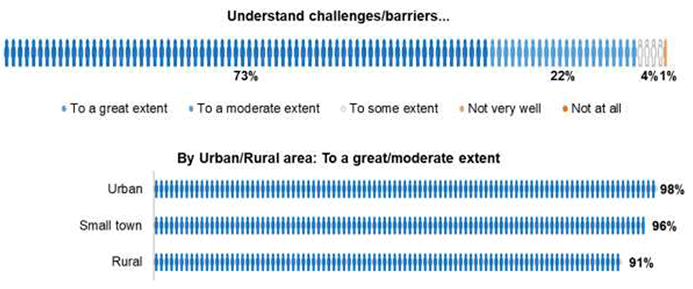
3.3. A great majority of headteachers also felt they had a good awareness of the range of approaches that can help to close the poverty-related attainment gap; 96% including 60% who felt they were 'very aware' of the range of approaches. Survey findings again indicated variation in views across urban and rural areas, with headteachers of schools in rural areas less likely to feel that they were aware of the range of potential approaches.
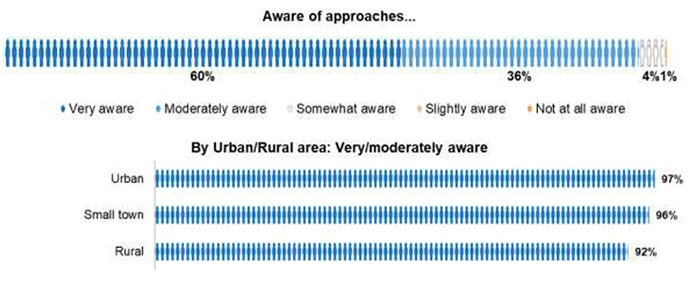
3.4. A great majority of headteachers felt confident in selecting approaches to close the poverty-related attainment gap that would be most effective in their school; 93% with around half of these feeling confident 'to a great extent'.
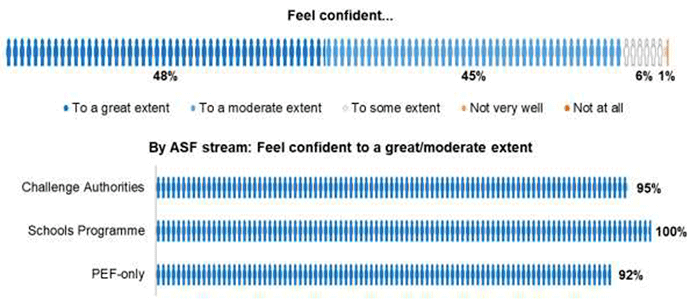
3.5. A large majority of headteachers indicated that the approach to achieving equity in education is embedded within their school community; 84% agreed that this was the case and only 2% disagreed.
3.6. There was some variation in views across key respondent groups. In particular, headteachers of PEF-only schools and those with lower PEF allocations were significantly less likely to feel that the approach to achieving equity is embedded.
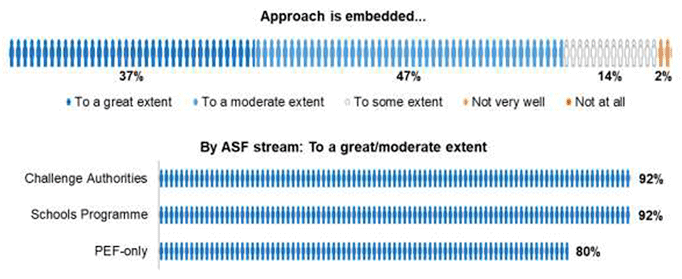
3.7. Follow-up qualitative feedback highlighted the perceived importance of ensuring the approach to achieving equity is fully embedded in schools.[6]
3.8. These schools noted the complexity involved in identifying what equity means in the context of a diverse school population. Some noted that their approach had sought to ensure that equal value is given to each pupil's skills and progress, while recognising that pupils' personal progress will vary. While some suggested that a focus on equity was already a key aspect of their approach, it was recognised that ASF had encouraged more focussed staff discussions around how to deliver the required impact for individual pupils, and encouraged pupils to be more supportive of their peers' individual progress.
"ASF support has opened the equity conversation out among the wider parent body, through dialogue with school staff and pupils. It has built staff awareness of the pupils most at risk, and what we can do long-term to make a positive impact."
Overview of ASF supported approaches
3.9. More than half (58%) of schools indicated that their approach to closing the poverty-related attainment gap in 2018/19 had been scaled-up from the previous year. A further 31% indicated that their approach had continued at the same level from the previous year, and around 1 in 10 (11%) had newly introduced their approach in 2018/19.
3.10. Most schools reported some change during the last year in their approach to closing the poverty-related attainment gap, although relatively few indicated that their approach was newly introduced in 2018/19. Around 2 in 3 (67%) indicated that there has been some change in approach, including 8% whose approach had changed significantly. Survey results show that PEF-only schools, particularly those with lower funding allocations, were less likely than Challenge Authority and Schools programme schools to have changed their approach over the past 12 months. A little more than half (54%) of schools with a lower PEF allocation had changed approach, compared to 80% of those with a higher allocation.
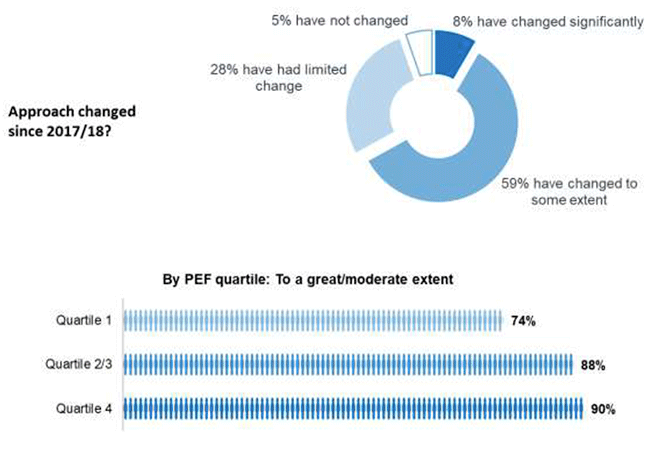
3.11. Written responses referred to a range of factors having influenced schools choosing to change their approach to closing the poverty-related attainment gap, or for schools maintaining a consistent approach. Qualitative analysis of these responses has been undertaken to identify the key factors mentioned by respondents. These are summarised over the page.
3.12. This analysis indicated that evaluation and measuring of impact was, by some margin, the most common reason for schools changing their approach to closing the poverty-related attainment gap. Around 2 in 5 of those who had changed approach indicated this had been in response to evidence collated through monitoring and evaluation. This ranged from schools making relatively minor refinements, to specific approaches or interventions being stopped where they were not delivering the anticipated impacts.
3.13. Evaluation and use of evidence was also the most common reason for schools choosing to continue their approach unchanged. Around 2 in 5 of those who had made little or no change to their approach indicated that this was based on their evaluation work having demonstrated positive impacts.
3.14. As is discussed in the next section, the majority of schools felt that their skills in use of data and evidence had improved through the fund. This was also evident in comments indicating that improved skills had given schools the confidence to change their approach in light of insufficient improvement, or retain their approach where they were able to demonstrate positive impacts.
| Evaluation, measuring impact, refining focus/ approach | 41% |
| Pupil and/or parent feedback, changing profile of needs | 14% |
| Change in funding or resourcing, including change in PEF allocation | 11% |
| Staffing and recruitment | 9% |
| Opportunities arising, including change of leadership | 8% |
| Staff feedback, increased awareness of impact of poverty | 6% |
| Change of focus over time (e.g. between literacy, numeracy, health and wellbeing) | 5% |
| Focus on sustainability | 4% |
| Value for money | 3% |
| Local authority strategy or direction | 3% |
| Evaluation, demonstrating impact | 38% |
| Limited funding or resourcing | 16% |
| Pupil and/or parent feedback | 8% |
| Staffing and recruitment | 7% |
| Focus on sustainability | 4% |
| Long-term planning | 3% |
| Staff feedback | 3% |
| Local authority strategy or direction | 3% |
Schools' focus for achieving equity in education
3.15. Survey responses indicated that the great majority of schools included a focus on the most deprived pupils and/or parents of the most deprived pupils as part of their approach to achieving equity in education. Nearly 9 in 10 (88%) of schools indicated this, and around 1 in 10 (9%) reported that their focus was solely on the most deprived. Most schools (61%) have taken a mixed approach, with a focus on the most deprived alongside other 'universal' approaches.
3.16. The survey indicated that the focus of approach varied somewhat across funding streams, most notably with Schools Programme respondents being more likely than others to focus only on the most deprived pupils and parents.
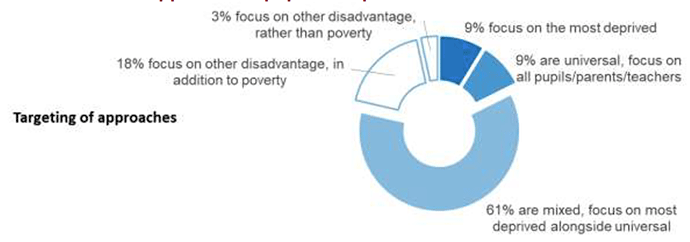
3.17. The survey also asked about the main themes around which schools' approach has been focused. The survey provided a list of potential areas of focus, and these are summarised below.
3.18. Responses indicated that schools had a relatively broad focus, with the great majority referring to multiple themes. Targeted support for individual pupils was the most common focus; around 3 in 4 schools (76%) indicated that their approach included a 'strong emphasis' on targeted support. Other common areas of focus included teaching skills or practice (52% with a strong emphasis), dedicated staff time (46%), culture and ethos (45%), resources or tools for teaching and learning (41%), and self-improvement or improvement planning (41%).
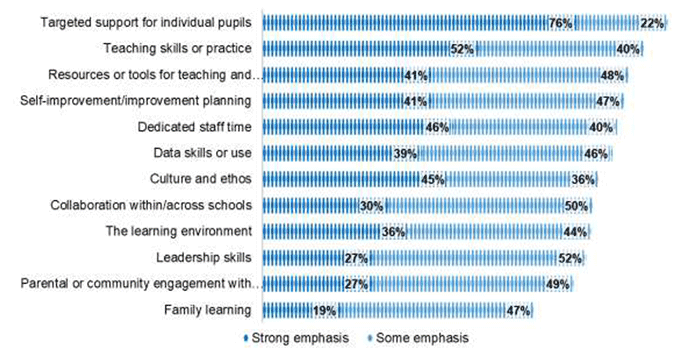
3.19. A small number of respondents (around 1 in 10) mentioned a focus on other themes, including:
- attendance and disengaged pupils;
- mental and physical health;
- building a sense of community and belonging within school;
- addressing school-related costs and financial exclusion;
- partnership working; and
- creating new opportunities and experiences for pupils and families.
Contact
Email: joanna.shedden@gov.scot
There is a problem
Thanks for your feedback